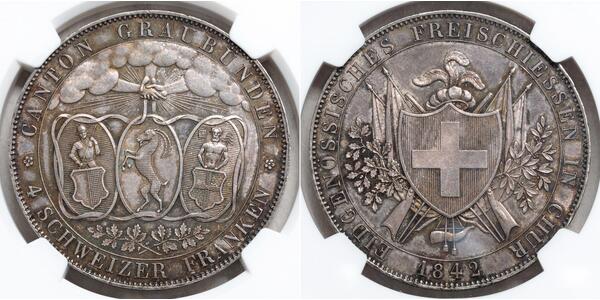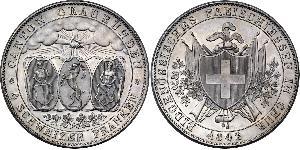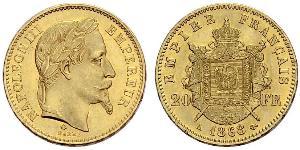4 Franc
1842, Switzerland, Graubunden. Beautiful Silver Shooting Thaler Coin. NGC MS-63!
Mint Year: 1842
Mint Place. Munich (Germany)
Condition: Certified and graded by NGC as MS-63!
References: Davenport 372, Richter 836a, KM-17 ($2300 in MS63!).
Denomination: 4 Francs (Shooting Thaler) - Chur Shooting Festival of 1842.
Mintage: 6,000 (1,744 pieces melted in 1852, for an upper limit of 4,256 surviving pieces!)
Material: Silver (.800)
Weight: 28.33gm
Diameter: 40mm
Obverse: Three clasped hands protruding from clouds, holding three coat-of-arms of the Three Leagues (the Grey League, Chur and the League of the Ten Jurisdictions) together. Oak-sprays in saltire below.
Legend: CANTON GRAUBÜNDEN – 4 SCHWEIZER FRANKEN
Translated: "Canton of Graubünden – 4 Swiss francs."
Reverse: Shield with coat-of-arms of the Swiss Confederation on flags and rifles in saltire and topped by a shooter´s hat. Oak-sprays to left, olive-sprays to right, hunter´s horn below.
Legend: EIDGENÖSSISCHES FREISCHIESSEN IN CHUR – 1842
Translated: "Federal Free Shoot in Chur – 1842."
Edge Legend: EINTRACHT MACHT STARK
Translated: "Harmony is strength."
A shooting thaler is a silver coin in thaler size minted to commemorate a Schützenfest (French: Fête de tir) or free shooting (German: Freischiessen, French: Tir libre) in Switzerland.
In a narrow sense, Swiss Schützentaler are the silver coins equal in size and weight to the Swiss 5 francs coin minted on the occasion of one of the Eidgenössische Schützenfeste, or federal shooting festivals. Two such coins were issued by the cantonal mints of Graubünden (1842, denominated at 4 Swiss francs), and Glarus (1847, denominated at 40 Batzen) prior to the establishment of the Federal Mint. Sometimes included as "shooting thaler" is a double thaler (10 francs) coin minted by Geneva and donated as cash prizes to the 1851 festival.
The Federal Mint has issued fifteen such coins with the nominal value of five francs, between 1855 and 1885. These coins were not intended as legal tender, even though they were issued by the federal mint with a nominal face value.
The Three Leagues, sometimes referred to as Raetia, was the alliance of 1471 of the League of God's House, the League of the Ten Jurisdictions, and the Grey League, leading eventually to the formation of the Swiss canton of Grisons (Graubünden). The territory corresponds to the core territory of Raetia Curiensis (ruled by the bishops of Chur as Prince-Bishopric of Chur), the early medieval remnant of the Roman province of Raetia prima.
On 29 January 1367, the League of God's House (German: Gotteshausbund, Italian: Lega Caddea, Romansh: Lia da la Chadéⓘ), was founded to resist the rising power of the Bishopric of Chur and the House of Habsburg. Bishop Peter Gelyto reacted by transferring the bishopric to the Habsburgs in exchange for a pension from the ducal house. The instrument of union was signed by envoys of the cathedral chapter, the episcopal Ministerialis, the city of Chur and the districts of Domleschg, Schams, Oberhalbstein, Oberengadin, Unterengadin and Bergell. Other districts joined the league subsequently, including the Poschiavo in 1408 and the Vier Dörfer in 1450. For some time, Unterengadin, Münstertal and the upper Vinschgau were disputed between the Bishopric of Chur and the County of Tyrol. While the first two could shake off the rule of the Habsburgs as count of Tyrol, in 1618, Untercalven was separated from the League as the last part of the Vinschgau.
The Grey League was founded in 1395 in the Upper Rhine valley, as a reaction to various feuds between the Barony of Belmont, the Lordship of Sax, the Barony of Rhäzüns, the Barony of Vaz, County of Werdenberg, Disentis Abbey and the Bishopric of Chur. The capital of the League was Ilanz. The name Grey League is derived from the homespun grey clothes worn by the people; the name of this league later gave its name to the canton of Graubünden.
The League of the Ten Jurisdictions was established on 8 June 1436, by the people of ten bailiwicks in the former county of Toggenburg, as the dynasty of Toggenburg had become extinct. The league was called League of the Ten Jurisdictions.
Chur or Coire is the capital and largest town of the Swiss canton of Grisons and lies in the Grisonian Rhine Valley, where the Rhine turns towards the north, in the northern part of the canton. The city, which is located on the right bank of the Rhine, is reputedly the oldest town of Switzerland. The official language of Chur is (the Swiss variety of Standard) German, but the main spoken language is the local variant of the High Alemannic Swiss German dialect.

|
Beigetragen von:
anonymous 2024-03-12 |
|
||
|
||
|
||
|
||
500 Reis Kingdom of Portugal (1139-1910) Silber Peter V of P ...
Diese Gruppe hat 2 Münzen / 2 Preise
⇑
1 Peso El Salvador Silber
Diese Gruppe hat 2 Münzen / 2 Preise
⇑




 Deutsch
Deutsch Русский
Русский Українська
Українська English
English Italiano
Italiano Français
Français Español
Español 汉语
汉语





-300-150-GbIdI28DtMIAAAF9jiID5Ziq.jpg)








